Ruth Ellen Gruber's Blog, page 17
August 7, 2011
Slovakia -- Following the Slovak Jewish Heritage Route
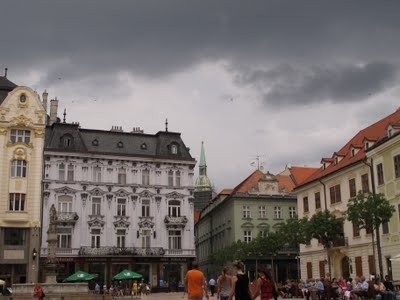 Brooding sky over Bratislava's main square. Photo (c) Ruth Ellen Gruber
Brooding sky over Bratislava's main square. Photo (c) Ruth Ellen GruberBy Ruth Ellen Gruber
I arrived in Bratislava today, to spend the coming week going around the country on the Slovak Route of Jewish Heritage -- a project devised by my friend Maros Borsky, the leading expert on Jewish heritage in Slovakia. The author of the book Synagogue Architecture in Slovakia, Maros founded and directs the Slovak Jewish Heritage Center.
I have been following the evolution of the Jewish Heritage Route from its very beginning. The Route now includes about 24 sites in all parts of Slovakia -- mainly synagogues and Jewish cemeteries. Each uses a common logo and each has a uniform plaque affixed to it, and each involves a partnership with a local body, such as a municipality, or a school, or local Jewish community, or another organization -- that, as a stakeholder, will work to make sure that the site is maintained and also used for educational purposes.
I have visited most of the sites in the past (and reported on some of them in this blog as well as in Jewish Heritage Travel and other writings).
Today we saw the modernist synagogue on Heydukova street, the only functioning synagogue to survive in the city. It was built in the 1920s for the Orthodox community and designed by Artur Szalatnai-Slatinský. It is a rather stark building, with seven pillars marking the street facade. The interior has some cubist elements and very interesting interior detail, including distinctive hanging lamps and a grille around the bimah that recalls gothic construction.
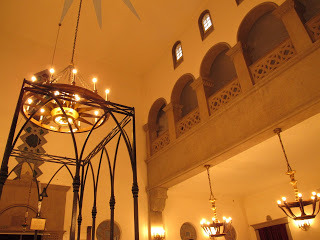 Photo (c) Ruth Ellen Gruber
Photo (c) Ruth Ellen GruberMaros showed us the work being done in the women's section, where next year an exhibition of Bratislava Jewry will be installed.
We briefly visited the Museum of Jewish Culture, a branch of the Slovak National Museum that reopened in 2009 following the revamping of its original exhibition, which dated from 1993. Although I wish this institution well, I have to say that today's visit did nothing to dispel the disappointment I felt when I was here about a year ago. The objects are arranged with little information about their history, provenance or significance. See my post from last September by clicking HERE.
Published on August 07, 2011 14:31
August 5, 2011
Poland -- Museum of the History of Polish Jewry
By Ruth Ellen Gruber
During the Jewish Culture Festival in Krakow last month, I spoke with Barbara Kirshenblatt Gimblett, who heads the team developing the core exhibit of the Museum of the History of Polish Jewry. The Q and A was published in The Forward.

During the Jewish Culture Festival in Krakow last month, I spoke with Barbara Kirshenblatt Gimblett, who heads the team developing the core exhibit of the Museum of the History of Polish Jewry. The Q and A was published in The Forward.
The museum has gone through some rough patches in recent months, with the departure, under pressure, of its director, Jerzy Halbersztadt, and financial shortfalls. What can you say about the status of the institution?
First of all, one of the great strengths of the institution is that it does not depend on one person. And that is a tribute to the former director. This museum has the good fortune to have a very, very good team. And the team has rallied and is functioning in a very positive way. So I'm optimistic….
Financially, we struggle. But we have donors, led by Sigmund Rolat and Tad Taube, that have been with us and supported us for many years.
What have been the main challenges? Are you satisfied with the process and result so far?
Although I first started coming to Poland in 1981, it was not until I began working on this project that I began to realize what it means to tell the story of how Polish Jews lived — and not only how they died — here, in the very place where they created such a vibrant civilization. That story has been overshadowed, understandably, by the Holocaust.… What began as a challenge — there is no collection of objects that could support such a compelling story — turned out to be an extraordinary opportunity and lesson, so to speak, in how to bring history to life using every possible medium.
How close is the exhibition to being installed?
Our goal is to open April 2013. When he visited the museum in May, President Obama promised to bring his daughters to the opening — and we'll hold him to it!
Read more: http://forward.com/articles/140845/#ixzz1U8jKIST1
Published on August 05, 2011 01:09
August 1, 2011
Hungary -- Bankito turns to civic action
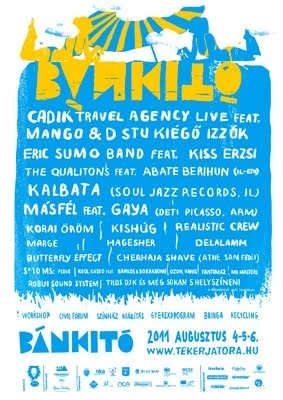
By Ruth Ellen Gruber
The annual Bankito alternative/youth Jewish culture festival on Bank lake north of Budapest takes place this week. And this year, besides music and arts, the program includes a big dose of social and civic activism -- in particular forging links between Jewish and Roma (Gypsy) youth groups to help promote volunteerism and minority pride and fight prejudice. And there are a number of workshops and discussion groups on topics relating to Jewish identity, studies, etc.
Published on August 01, 2011 01:08
July 26, 2011
Poland: New cemetery signage in Lutowiska and Starachowice
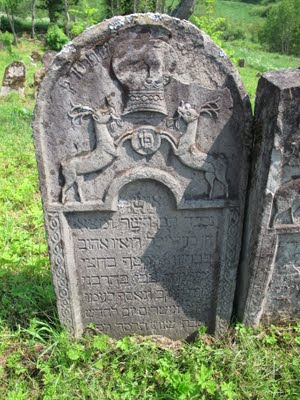 Lutowiska. Photo (c) Ruth Ellen Gruber
Lutowiska. Photo (c) Ruth Ellen GruberBy Ruth Ellen Gruber
I posted recently on the exemplary fashion in which Jewish heritage sites are cared for and put on local tourism and heritage itineraries in the remote village of Lutowiska in the far southeast corner of Poland.
There is even more signage point the way to the Jewish cemetery there now, thanks to the support of the Michael Traison Fund for Poland, the Community Office of Lutowiska and the Foundation for the Preservation of Jewish Heritage in Poland (FODZ) which erected a new information plaque and road sign.
Michael's fund, the FODZ and the Town Office of Starachowice also put up two new road signs marking the way to the local Jewish cemetery there (where I have never been).
Published on July 26, 2011 10:54
Poland: Oswiecim, the city of Auschwitz, wrestles with whether the past must be part of its future
My latest JTA story is about Oswiecim, the town outside of which Auschwitz was built.
 Woman walks her baby in front of the Auschwitz Jewish Center. Photo (c) Ruth Ellen Gruber
Woman walks her baby in front of the Auschwitz Jewish Center. Photo (c) Ruth Ellen Gruber
By Ruth Ellen Gruber
JTA, July 21, 2011
OSWIECIM, Poland (JTA) -- Can a town that exists in the shadow of death transform itself into a place of normalcy?
The question long has vexed Oswiecim, the town of 40,000 in southern Poland where the notorious Auschwitz death camp is located.
For decades, residents and city leaders have struggled to separate Oswiecim from Auschwitz and pull the town, its history and its cultural associations out from under the overwhelming black cloud of the death camp, which is now a memorial museum.
With only limited success to date, however, a new generation of town leaders is trying a different tack: bolstering Oswiecim as a vital local community, but also reaching out to connect with Auschwitz rather than disassociate from it.
"Ten or 15 years ago, many of us began thinking that the way to go was not to reject Auschwitz but to deal with it," said historian Artur Szyndler, 40, the director of research and education at the Auschwitz Jewish Center who grew up in Oswiecim under communism.
The town has adopted "City of Peace" as its official slogan. And for years a Catholic-run Dialogue and Prayer Center and a German-run International Youth Center near the camp have promoted reflection and reconciliation.
Downtown, the 10-year-old Auschwitz Jewish Center makes clear that before the Holocaust, Oswiecim had a majority Jewish population and was known widely by its Yiddish name, Oshpitzin. The center includes a Jewish museum and a functioning refurbished synagogue -- the only one in the city to survive. It runs study programs and serves as a meeting place for visiting groups.
And now the Oswiecim Life Festival, founded last year by Darek Maciborek, a nationally known radio DJ who was born and lives in Oswiecim, aims to use music and youth culture to fight anti-Semitism and racism.
"This place seems to be perfectly fitting for initiatives with a message of peace," Maciborek said. "A strong voice from this place is crucial."
The closing concert of this year's festival, held in June, included the Chasidic reggae star Matisyahu. He gave a midnight performance for a crowd of 10,000 in a rainswept stadium just a couple of miles from the notorious "Arbeit Macht Frei" ("work sets you free") gate of the death camp.
"It was an incredibly symbolic moment," Oswiecim City Council President Piotr Hertig told JTA. "It was a very important symbol that a religious Jew was performing at a festival in such a place."
Hertig said the new push to bolster Oswiecim and reach out more to the Auschwitz museum and its visitors is partly due to a generational shift in the town.
For a long time, most of Oswiecim's population consisted of thousands of newcomers from elsewhere in Poland who settled here after World War II. But today's community leaders increasingly include 30- and 40-somethings like Hertig and Maciberok who were born in Oswiecim and feel rooted here.
The town now has plans to go ahead with several projects that had been thwarted by outgoing Mayor Janusz Marszalek, who had particularly strained relations with the Auschwitz Memorial, according to Hertig. These include a new visitors' center for the memorial and a park on the riverbank just opposite Auschwitz that will be connected to the camp memorial by a foot bridge.
"This will be a very good place for people to come after visiting Auschwitz and Birkenau, where they can meditate, reflect and soothe their negative emotions," Hertig said.
Hertig said he hoped new programs and study visits developed with the Auschwitz memorial will encourage longer stays by visitors. Plans are in the works to build an upscale hotel in town and refurbish the main market square and other infrastructure.
"Auschwitz, on our outskirts, is the symbol of the greatest evil," Hertig said. "But at the same time we want to show to others that Oswiecim is a town with an 800-year history that wants to be a normal living town."
Located on the opposite side of the Sola River from the Auschwitz camp, Oswiecim has an old town center with a pleasant market square, several imposing churches, and a medieval castle and tower. In the modern part of town is a new shopping mall and state-of-the-art public library, as well as a big civic culture center that hosts a variety of events, including an annual Miss Oswiecim beauty pageant.
But few of the more than 1.2 million people who visit the Auschwitz camp each year ever set foot in Oswiecim or even know that the town exists.
"It is difficult to comprehend what it must be like to call this city your hometown," said Jody Manning, a doctoral student at Clark University in Worcester, Mass., who is writing a dissertation on life in Oswiecim and Dachau, Germany, also the site of a concentration camp.
Local residents long have resented that most outsiders make no distinction between their town and the death camp.
"People from outside are sometimes shocked. They ask how I can live in Auschwitz. But I don't -- I live in Oswiecim," said Gosia, a 30-year-old woman who works at the Catholic Dialogue Center. "This is Oswiecim, my hometown -- not Auschwitz!"
It remains to be seen whether the new push can help remove the stigma from Oswiecim and achieve a less strained modus vivendi with the death camp memorial. "People have the right to live normally, but I don't think they'll be able to disassociate from Auschwitz," said Stanislaw Krajewski, a leading Polish Jewish intellectual. "The best they can do is to use it in a constructive way; the very name Auschwitz has a magical power."
 Woman walks her baby in front of the Auschwitz Jewish Center. Photo (c) Ruth Ellen Gruber
Woman walks her baby in front of the Auschwitz Jewish Center. Photo (c) Ruth Ellen GruberBy Ruth Ellen Gruber
JTA, July 21, 2011
OSWIECIM, Poland (JTA) -- Can a town that exists in the shadow of death transform itself into a place of normalcy?
The question long has vexed Oswiecim, the town of 40,000 in southern Poland where the notorious Auschwitz death camp is located.
For decades, residents and city leaders have struggled to separate Oswiecim from Auschwitz and pull the town, its history and its cultural associations out from under the overwhelming black cloud of the death camp, which is now a memorial museum.
With only limited success to date, however, a new generation of town leaders is trying a different tack: bolstering Oswiecim as a vital local community, but also reaching out to connect with Auschwitz rather than disassociate from it.
"Ten or 15 years ago, many of us began thinking that the way to go was not to reject Auschwitz but to deal with it," said historian Artur Szyndler, 40, the director of research and education at the Auschwitz Jewish Center who grew up in Oswiecim under communism.
The town has adopted "City of Peace" as its official slogan. And for years a Catholic-run Dialogue and Prayer Center and a German-run International Youth Center near the camp have promoted reflection and reconciliation.
Downtown, the 10-year-old Auschwitz Jewish Center makes clear that before the Holocaust, Oswiecim had a majority Jewish population and was known widely by its Yiddish name, Oshpitzin. The center includes a Jewish museum and a functioning refurbished synagogue -- the only one in the city to survive. It runs study programs and serves as a meeting place for visiting groups.
And now the Oswiecim Life Festival, founded last year by Darek Maciborek, a nationally known radio DJ who was born and lives in Oswiecim, aims to use music and youth culture to fight anti-Semitism and racism.
"This place seems to be perfectly fitting for initiatives with a message of peace," Maciborek said. "A strong voice from this place is crucial."
The closing concert of this year's festival, held in June, included the Chasidic reggae star Matisyahu. He gave a midnight performance for a crowd of 10,000 in a rainswept stadium just a couple of miles from the notorious "Arbeit Macht Frei" ("work sets you free") gate of the death camp.
"It was an incredibly symbolic moment," Oswiecim City Council President Piotr Hertig told JTA. "It was a very important symbol that a religious Jew was performing at a festival in such a place."
Hertig said the new push to bolster Oswiecim and reach out more to the Auschwitz museum and its visitors is partly due to a generational shift in the town.
For a long time, most of Oswiecim's population consisted of thousands of newcomers from elsewhere in Poland who settled here after World War II. But today's community leaders increasingly include 30- and 40-somethings like Hertig and Maciberok who were born in Oswiecim and feel rooted here.
The town now has plans to go ahead with several projects that had been thwarted by outgoing Mayor Janusz Marszalek, who had particularly strained relations with the Auschwitz Memorial, according to Hertig. These include a new visitors' center for the memorial and a park on the riverbank just opposite Auschwitz that will be connected to the camp memorial by a foot bridge.
"This will be a very good place for people to come after visiting Auschwitz and Birkenau, where they can meditate, reflect and soothe their negative emotions," Hertig said.
Hertig said he hoped new programs and study visits developed with the Auschwitz memorial will encourage longer stays by visitors. Plans are in the works to build an upscale hotel in town and refurbish the main market square and other infrastructure.
"Auschwitz, on our outskirts, is the symbol of the greatest evil," Hertig said. "But at the same time we want to show to others that Oswiecim is a town with an 800-year history that wants to be a normal living town."
Located on the opposite side of the Sola River from the Auschwitz camp, Oswiecim has an old town center with a pleasant market square, several imposing churches, and a medieval castle and tower. In the modern part of town is a new shopping mall and state-of-the-art public library, as well as a big civic culture center that hosts a variety of events, including an annual Miss Oswiecim beauty pageant.
But few of the more than 1.2 million people who visit the Auschwitz camp each year ever set foot in Oswiecim or even know that the town exists.
"It is difficult to comprehend what it must be like to call this city your hometown," said Jody Manning, a doctoral student at Clark University in Worcester, Mass., who is writing a dissertation on life in Oswiecim and Dachau, Germany, also the site of a concentration camp.
Local residents long have resented that most outsiders make no distinction between their town and the death camp.
"People from outside are sometimes shocked. They ask how I can live in Auschwitz. But I don't -- I live in Oswiecim," said Gosia, a 30-year-old woman who works at the Catholic Dialogue Center. "This is Oswiecim, my hometown -- not Auschwitz!"
It remains to be seen whether the new push can help remove the stigma from Oswiecim and achieve a less strained modus vivendi with the death camp memorial. "People have the right to live normally, but I don't think they'll be able to disassociate from Auschwitz," said Stanislaw Krajewski, a leading Polish Jewish intellectual. "The best they can do is to use it in a constructive way; the very name Auschwitz has a magical power."
Published on July 26, 2011 10:03
Moldova -- Video of Vadul Rascov
By Ruth Ellen Gruber
Simon Geissbuehler turned me on to the extremely evocative Jewish cemetery in Vadul Rascov, a rather remote village and former shtetl in Moldova.... I've never been there, but Simon loves the place and he and others who have made the trek have written about it and taken wonderful photos.
Simon sent the link to a TV video clip (in Romanian) about the place. What strikes me is not just the site itself but the relatively recent dates on the gravestones that are shown.

Simon Geissbuehler turned me on to the extremely evocative Jewish cemetery in Vadul Rascov, a rather remote village and former shtetl in Moldova.... I've never been there, but Simon loves the place and he and others who have made the trek have written about it and taken wonderful photos.
Simon sent the link to a TV video clip (in Romanian) about the place. What strikes me is not just the site itself but the relatively recent dates on the gravestones that are shown.
Published on July 26, 2011 08:35
July 25, 2011
Ukraine -- thoughtful report on the L'viv klez fest; virtually and non-virtually Jewish
By Ruth Ellen Gruber
My friend Sarah Zarrow is just wrapping up a stint of living and researching in L'viv. I have recommended her blog -- her most recent post is a thoughtful take and description -- with pictures -- of the L'viv Klez Fest, which I have never been to.

My friend Sarah Zarrow is just wrapping up a stint of living and researching in L'viv. I have recommended her blog -- her most recent post is a thoughtful take and description -- with pictures -- of the L'viv Klez Fest, which I have never been to.
Perhaps because of demographic changes, sometimes festivals feel like a Jewish version of "add women and stir." Take some hummus, some d minor, and some hava nagila…poof! Instant Jewish. Part of the festival is a street fair on Staroevreiska (the old Jewish street, in the oldest section of town). "Jewish" is sort of a stand-in, it seems, for old, antique, quaint. Laundry hangs from some cords, signs for LvivKlezFest hang on others.
I get fake Jewish stuff, some times. I don't always find it pleasing, or even acceptable, but I don't get offended; I often can see where it comes from, even if I don't like it. And I admit a certain fondness for it, sometimes. Fiddler-esque kitsch has an appeal. What I don't get is when Jews really buy into it. It's like black people in blackface, and it's not done (at least, it doesn't look like it here) self-consciously, as burlesque….I got pretty grumpy, until I was knocked out of my snottiness by two people: Harald Binder, the President of the Board of the Center for Urban History, who made the excellent point that a vision of Jews as culture makers, party-throwers, and generally happy and friendly people would be better than the general view of Jews in L'viv now. And Zhenya reminded me that people were happy, and that happiness wasn't a bad thing. Which I forget, even after being away from New York for two months.
Published on July 25, 2011 01:00
July 24, 2011
Poland -- visit to Dukla
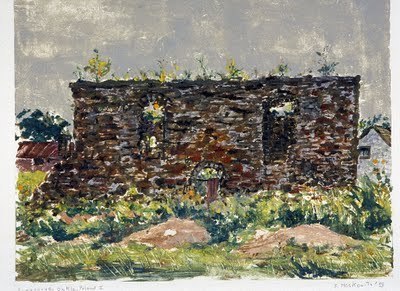 Dukla's ruined synagogue, monotype by Shirley Moskowitz, 1993. (c) Estate of Shirley Moskowitz
Dukla's ruined synagogue, monotype by Shirley Moskowitz, 1993. (c) Estate of Shirley MoskowitzBy Ruth Ellen Gruber
One of Polish towns I visited in June was Dukla, a small town in the far south of the country at the top of the Dukla Pass just north of the border with Slovakia. Here, just off the rather run-down market square, stand the gaping ruins of a once imposing synagogue.
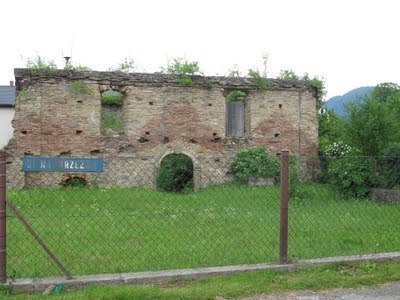 Photo (c) Ruth Ellen Gruber
Photo (c) Ruth Ellen GruberAnd there are two Jewish cemeteries at the edge of town, marked from the road with a sign indicating it is a war memorial site.
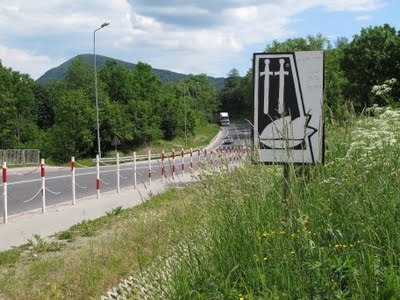 Photo (c) Ruth Ellen Gruber
Photo (c) Ruth Ellen GruberThe walled newer cemetery, entered through a rusting gate, had a few neat rows of stones, some with fairly interesting carving -- and the whole area was nicely maintained, with freshly-cut grass/weeds.
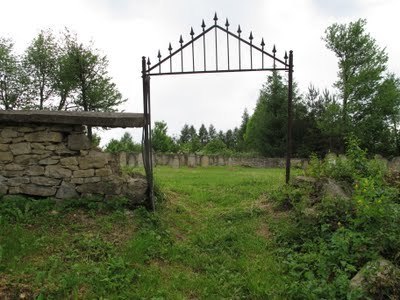 Photo (c) Ruth Ellen Gruber
Photo (c) Ruth Ellen Gruber Dulka. Photo (c) Ruth Ellen Gruber
Dulka. Photo (c) Ruth Ellen GruberAcross the dirt road, though, the eroding gravestones in the old cemetery were scarcely visible in the thick vegetation.
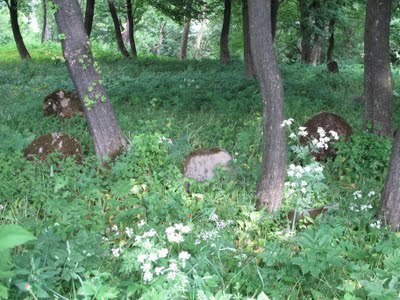 Dukla. Photo (c) Ruth Ellen Gruber
Dukla. Photo (c) Ruth Ellen GruberI first visited Dukla in, I believe, 1992, when I was researching my book "Upon the Doorposts of thy House: Jewish Life in East Central Europe, Yesterday and Today." (The book is out of print, but I am planning to re-issue it as an e-book on Kindle.) Things are much today as they were then, though the market square seemed a bit more run-down and less quaint this time around.
This is what I wrote about Dukla in "Doorposts":
The Dukla Pass is the lowest and easiest north-south route through the western Carpathians, and by the 16th century it was already a well-established artery for trade, including the wine trade. the town of Dukla itself prospered as a major center for the import of Hungarian wine, though Ber of Bolechow [the 18th century wine merchant and Jewish leader from what is now Bolekhiv in Ukraine] recounted that the Jewish wine traders from there were not always quite honest. He told the story of a certain Reb Hayyim of Dukla, who made a large purchase of wine in the Hungarian town of Miskolc at the same time that Ber's brother and two other associates were there. Unfortunately, Reb Hayyim paid the Hungarian suppliers with counterfeit money -- golden ducats that turned out to be gold-plated copper -- and Ber's brother and a friend were arrested along with Hayyim, even though it was acknowledged that they had not held any of the bad coins.On that trip, I brought my mother, the artist Shirley Moskowitz, with me -- and she produced a cycle of montoype prints of some of the Jewish heritage sites we visited -- including the one of Dukla synagogue at the top of this post. The cycle of prints was exhibited in several places in Poland in the early 2000s, and now many of them are posted on the web site that we established for her and her artwork after her death in 2007.
The three were kept in jail for a year, until, after much nerve-wracking investigation, the origin of the bad coins was traced to a monastery, which in turn had received them from local noblemen, who made a practice of circulating debased coinage at that time. Ber's brother was released from prison and was even paid a considerable sum in compensation for wrongful arrest, Ber wrote. But the affair had taken a toll: the stress and tension had caused Ber to break out in spots.
During World War II the Dukla Pass was the scene of bitterly fought battles between combined Czechoslovak and Soviet armies and the Germans. The bloody mountain fighting in the autumn of 1944 destroyed the German defenses and left 100,000 soldiers dead. The towns of Dukla, to the north of the pass, and Svidnik in Slovakia to the south, were almost totally razed. I passed numerous memorials to this fighting as I drove along the gentle curves through the wooded hills. Monuments had been erected to the fallen, and ruined tanks, artillery pieces, and airplanes had been left in place where they had been at the close of he conflict, rusting memorials to the battle.
Dukla itself was a small town clustered around a stage-set market square with a white market hall at its center. Nearby, I found the synagogue. It had been built around the middle of the 18th century, and the wily Reb Hayyim may will have worshipped there. Now it was a ruin. It had been destroyed during the wartime battles and had simply been left as it was, four massive stone walls and little else, looming in a small hollow. At the edge of town, a few graves still stood in the Jewish cemetery, surrounded by a brilliant carpet of wild spring flowers.
Published on July 24, 2011 09:29
July 23, 2011
Ukraine -- Struggle to recognize and recover Jewish heritage and history
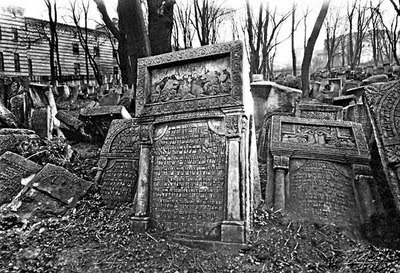 Old Jewish Cemetery in L'viv -- now destroyed and built over by a marketBy Ruth Ellen Gruber
Old Jewish Cemetery in L'viv -- now destroyed and built over by a marketBy Ruth Ellen GruberThe Kyiv Post has run a 5-part series over the past few weeks about the struggle of memory over Jewish heritage and history in Ukraine in the wake of the Holocaust.
One of the articles, which are by Natalia A. Feduschak, focuses on the valiant Meylakh Sheykhat and his tireless battles to preserve and honor Jewish heritage sites.
For nearly two decades, often working with limited resources, Sheykhet has tirelessly traveled throughout western Ukraine to ensure Jewish cultural remnants are preserved. It has not been an easy job for the 58-year-old, who has lived in Lviv nearly his entire life.
Not only is Sheykhet racing against time, neglect and the elements, he is also fighting apathy from some segments of the Ukrainian population, which does not always recognize Jewish culture as part of its own.
For instance, since 2003 he has been at loggerheads with local officials in Sambir, a town south of Lviv, to remove three large Christian crosses erected in the Jewish part of the cemetery. Visits by international figures like former Canadian-Ukrainian parliamentarian Borys Wrzesnewskyj and Mark Freiman, president of the Canadian Jewish Congress, have not changed local minds.
Before World War II, today's western Ukraine boasted artifacts that reflected a culturally rich Jewish life. The landscape was dotted with cemeteries and synagogues, while towns and villages, often home to a population comprised largely of Jews, bore entire Jewish quarters with unique religious and residential structures.
Read more: http://www.kyivpost.com/news/nation/detail/108659/#ixzz1SvAkERYp
Read a profile of Meylach HERE
Published on July 23, 2011 03:05
July 18, 2011
L'viv -- Read Sarah Zarrow's Blog
By Ruth Ellen Gruber
My friend Sarah Zarrow is a graduate student who has been doing research work in L'viv (and elsewhere) this summer. Her blog, Sarah w Polsce, presents a vivid picture of life and conditions there, with lots of pictures. (The blog title means "Sarah in Poland" and stems from her previous research trip, last year.) Sarah is researching (at least in part) a great collection of Judaica put together between WW1 and WW2 and today held unseen in the ethnographic muscum,
Her reports are lively and candid -- and she includes info on day trips outside of the city.
My friend Sarah Zarrow is a graduate student who has been doing research work in L'viv (and elsewhere) this summer. Her blog, Sarah w Polsce, presents a vivid picture of life and conditions there, with lots of pictures. (The blog title means "Sarah in Poland" and stems from her previous research trip, last year.) Sarah is researching (at least in part) a great collection of Judaica put together between WW1 and WW2 and today held unseen in the ethnographic muscum,
Her reports are lively and candid -- and she includes info on day trips outside of the city.
Published on July 18, 2011 00:15



